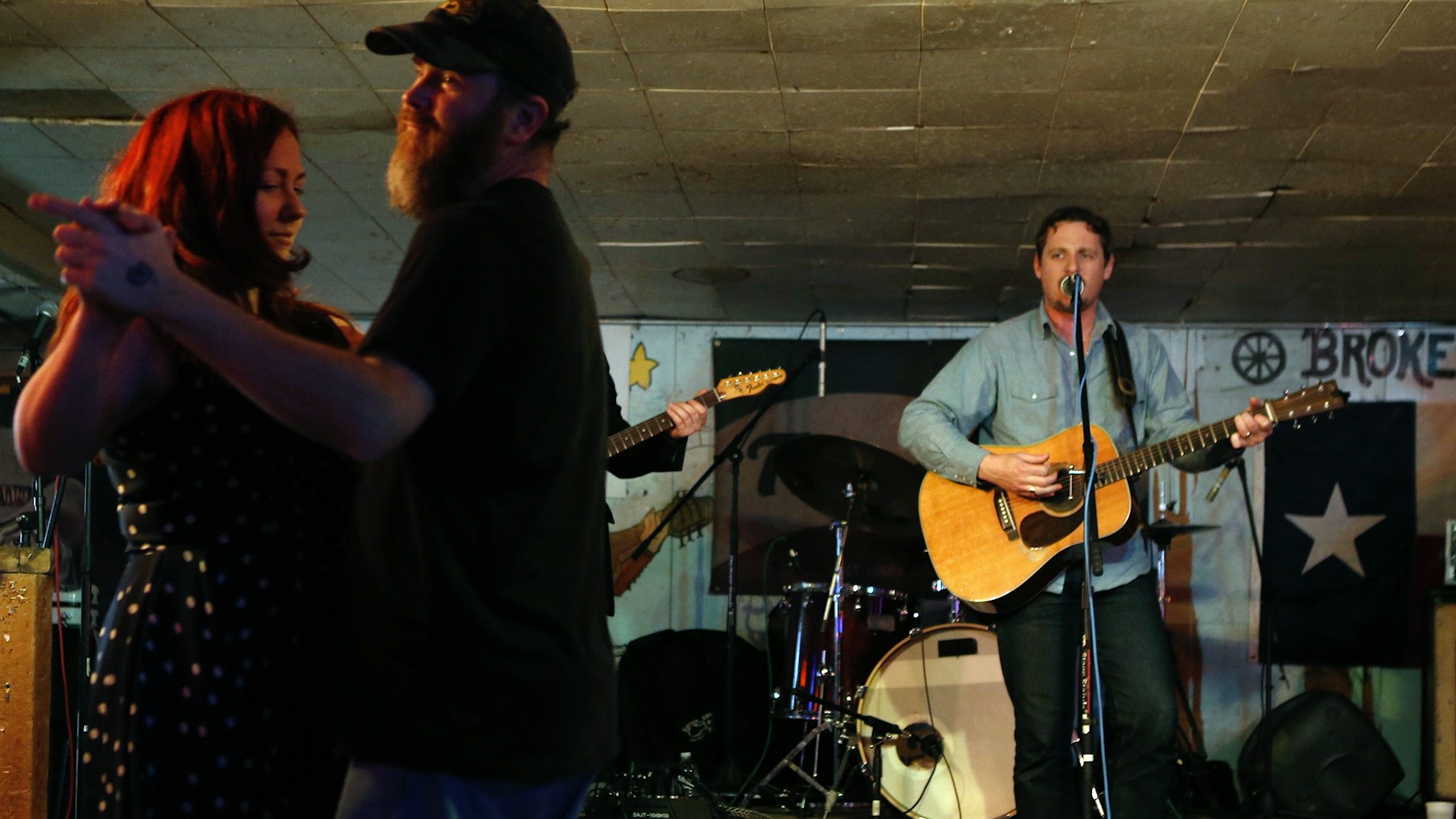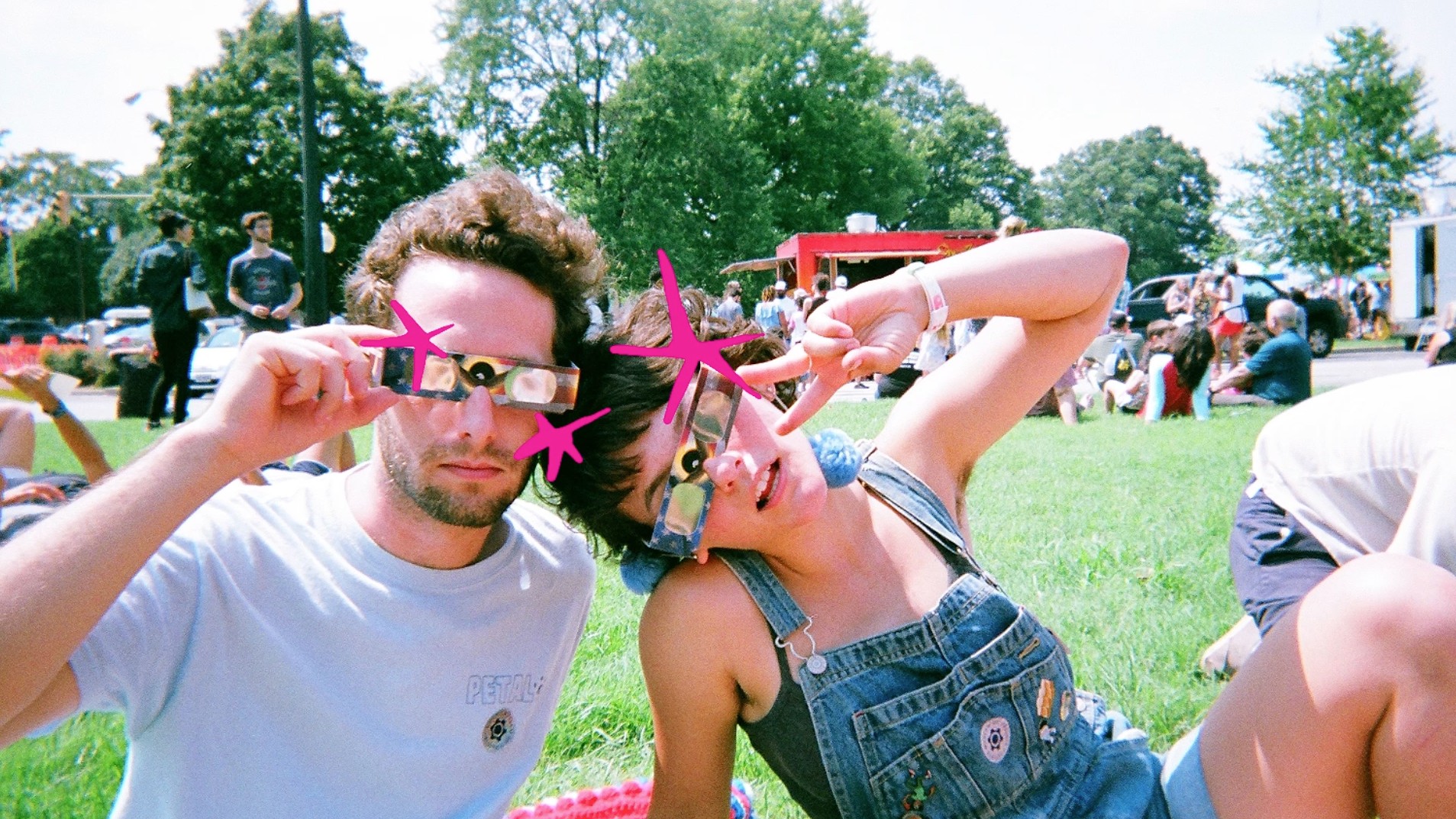This story appears in VICE magazine and Noisey's 2017 Music Issue. Click HERE to subscribe to VICE magazine.There are a lot of scents wafting through the White Horse in Austin on a Saturday night: whiffs of hot popcorn from a machine by the entrance, the stale odor of puddles of spilled Lone Star, the aroma of the Bomb Tacos cart outside, and, on the August evening of my visit, the lingering trace of sweat emanating from a buzzing crowd. Onstage, local duo Mayeux and Broussard were getting the crowd to two-step the night away. Tate Mayeux is a long-haired crooner, and Brian Broussard lends a shreddy vibe to his twang; both rockers are still grounded in their country roots. The crowd was steady, with some room left on the floor, when Mayeux yelled out, "Who likes Beyoncé?" They didn't segue into one of her songs, but the call was enough to swell the dancing mob of bodies with grace and swiftness.
Advertisement
The "honky-tonk" bands that play the White Horse are mostly electric country in the outlaw tradition of Texas's favorite son, Willie Nelson, and the likes of Merle Haggard. The term can refer to both the genre and the venues in which it's played, and those who play it will often cater their performance to two-step dancers, who are a sight to behold: coordinated and nimble, but with classic Austin looseness. People come out for this scene—even on Tuesday and Wednesday nights, the nadir of any nightlife (especially Austin's).Honky-tonk music and two-step dancing have long been a thing in Austin—and all over Texas, really—but around the turn of this decade, young people, specifically the hip, alternative young people who "keep Austin weird," began reconnecting with this distinct part of Texas heritage.
At the White Horse, co-owned by Denis O'Donnell, patrons tend to be younger with diverse musical tastes.
Dancing culture has always had a home in Texas—Gruene Hall, one of Texas's oldest dance halls, is about an hour from Austin, in New Braunfels, and dates back to 1878. The Texas two-step likely descends from the significant Czech and German influence in central Texas, though it's also a clear adaptation of the foxtrot, popularized by Harry Fox in the 1910s. The dance emphasizes a brisk glide instead of the foxtrot's fast hopping, and its slower pace also accommodates the flourishes of swing dancing, another precursor to two-stepping. In the mid 30s and 40s, Bob Wills and His Texas Playboys helped advance Texas two-step dancing as we know it, by conforming those traditions to standard 4/4 patterns—the most familiar rhythm in Western popular music—and laying it down on the fiddle to really get crowds going. Then with the release of Urban Cowboy in 1980, it became a nationwide trend. While the film helped country music reach a larger audience, two-stepping is still mainly a Texas thing—they'll look at you funny in Nashville for doing what Austin country-staple Dale Watson termed "Quick Quick Slow Slow."
Advertisement
It is a couple's dance, with two quick steps followed by two slow steps, while holding your partner close. It's supposed to go counterclockwise on the dance floor, though that isn't strictly enforced. And there's a big twist or swoop after a few stepping routines—that's where the creativity and excitement come in. Some people are faster than others, some slower. Some are more reserved, some really make a show of it.There are a lot of places for two-stepping in Austin, but Broken Spoke is still the premier honky-tonk bar in the city, courting an audience since 1964 with its dance floor, western decor, and chicken fried steak. The Continental Club, a bar on South Congress Avenue, where seemingly every Austin legend has played, is another popular place to gather and dance. Austin Beer Garden Brewing Company is newer, but has a great floor and equally great beer. The Little Longhorn Saloon, known as "Ginny's," up on Burnet Road, is also home to plenty of honky-tonk, when it's not hosting Chicken Shit Bingo (which is exactly what it sounds like). For the younger crowd, though, the White Horse is king, and its co-owner Denis O'Donnell, who came to Austin from Houston, has played a big part in honky-tonk's resurgence in the city. The White Horse, which opened in 2011 and is located just a block south of the East Sixth Street bar stretch, is a country bar through and through, but it doesn't neatly fit into a stereotype. Thinking about a typical country bar may bring to mind sprawling dance halls like Gilley's, the former Pasadena, Texas, club made famous as the setting of Urban Cowboy. But the White Horse is a dive—dimly lit and adorned with vintage Lone Star and Schlitz signs featuring black and Hispanic couples, holdovers from the club's previous incarnation as El Trompo, a bar that played traditional norteño music. Austin doesn't actually have a lot of big-time dance halls (its closest Gilley's analogues, Midnight Rodeo and Dallas Nightclub, closed some time back); instead there's a spread of small honky-tonk joints.
The White Horse, which opened in 2011 and is located just a block south of the East Sixth Street bar stretch, is a country bar through and through, but it doesn't neatly fit into a stereotype. Thinking about a typical country bar may bring to mind sprawling dance halls like Gilley's, the former Pasadena, Texas, club made famous as the setting of Urban Cowboy. But the White Horse is a dive—dimly lit and adorned with vintage Lone Star and Schlitz signs featuring black and Hispanic couples, holdovers from the club's previous incarnation as El Trompo, a bar that played traditional norteño music. Austin doesn't actually have a lot of big-time dance halls (its closest Gilley's analogues, Midnight Rodeo and Dallas Nightclub, closed some time back); instead there's a spread of small honky-tonk joints.

Advertisement
Austin's reputation as a liberal and inviting oasis isn't exactly reflected in the demographics—there are still a lot of white people dancing—but the crowd at the White Horse does tend to be a bit more mixed than a stereotypical country bar. The crowd is younger, with hipster kids who soaked up country in their parents' trucks, and a lot of the folks who walk in will also bop to Houston rap classics "Still Tippin'" and "Wanna Be a Baller" at the Eastern, a dive bar next door—it's all Texas.O'Donnell intended for the White Horse to be an incubator for young, undiscovered country acts, drawing upon Austin's wide talent pool. He makes it a point to not host many touring acts, freeing the stage for locals looking to make a name for themselves. When he was still a bartender at Hole in the Wall, a mainstay of the "Drag," a once-hip commercial district that's been overtaken by chains in the past decade, O'Donnell knew that when he opened his own place, honky-tonk would be the focus. At Hole in the Wall, he hosted a two-stepping night on Mondays, the success of which gave him his first taste of what the White Horse would become.When we spoke at Hard Luck Lounge, another bar he runs farther east, O'Donnell wanted to make it clear that line dancing is different from two-stepping and that line dancing has never been and will never be cool. At the White Horse, he assured me the law gets laid down. Its owners are not with the corny shit. He recounted a story about a time when Roger Wallace, a musician from Tennessee, was performing. "Roger Wallace sees four or five girls line dancing," he said. "And he stops in the middle [of playing] and says, 'We two-step here.' There is no line dancing."
Advertisement
That fervent rejection of corniness may be a reason for two-step's resurgence with young people, at O'Donnell's bar especially. Honky-tonk barely resembles pop country's artifice and commercial rock's gloss. The likes of Florida Georgia Line and Toby Keith and Pat Green would get booed out of the White Horse with impunity. "Popular country has degenerated into this commercialized trash of pitch correction and starlings… it doesn't sell in Austin," O'Donnell told me.The city has come to embody the worst connotations of words like "authentic," "craft," and "real," usually referring to overpriced tacos and $10 cocktails encroaching on the last affordable housing it has to offer. But in honky-tonk and two-stepping, it embodies the best about those terms too."It's plainspoken narrative lyrics that punk, hip-hop, folk, and country all share—the language you use is the language of your audience. It's not flowery or overly poetic," said Corey Baum, who sings for the country band Croy and the Boys. "Anybody that appreciates honest music can like country."
At the Broken Spoke (left), Austin's premier honky-tonk bar, drinkers and dancers skew toward an older, more traditional crowd. At the White Horse, co-owned by Denis O'Donnell (right), patrons tend to be younger with diverse musical tastes.
The authenticity connection may have something to do with a punk-to-country crossover that's also common with many of the younger musicians in the scene, and there's historical precedent for the connection between the two genres. The singer Dwight Yoakam cut his teeth playing in punk clubs in LA; notorious punk scumbag G.G. Allin considered Hank Williams, the godfather of country, to be a spiritual influence; Williams's grandson Hank III has a strong following among metal-heads and punks and has played in two hardcore groups with former Pantera front man Phil Anselmo; and Johnny Cash's mid-90s, Rick Rubin–fueled comeback was aided by Misfits founder Glenn Danzig writing "Thirteen" for him. You'll see plenty of musicians cross over between punk gigs and the White Horse Saturday nights.
Advertisement
"Roots of authentic country music, in Texas especially, if you were to take that back 150 years, it was singing about politics, alcoholism, prison, jail… telling the human condition and doing so in brutal honesty," O'Donnell said. "Where we grew up playing punk rock music, it was about class, poverty, and alcohol—that was the same thing Johnny Cash and Jimmy Rogers were singing about."Punk, at least in the beginning, had appeal for its approachability: no managers, no guitar lessons, the world was yours. Two-stepping has a similar charm in that regard. Even if you've never done it in your life, if someone asks you to dance, you'll learn as you go. Beginners are still pretty good approximations of the best dancers. While both the White Horse and Broken Spoke offer lessons, the Spoke's history and older crowd lend to a little intimidation, the White Horse not so much."You can learn to dance at the White Horse just by doing it. You don't even have to be good at it. It became an outlet to go and do that without having to impress somebody," Mike Harmeier of Mike and the Moonpies, a popular Austin country group that got started at Hole in the Wall and the White Horse, recalled. "It's very traditional at Broken Spoke, and everything is about tradition at Broken Spoke. At the White Horse, you just get on the floor and go. It's a little more freewheeling in that regard." Plus, Harmeier added, "It's still a good excuse for people to get laid."
Advertisement
